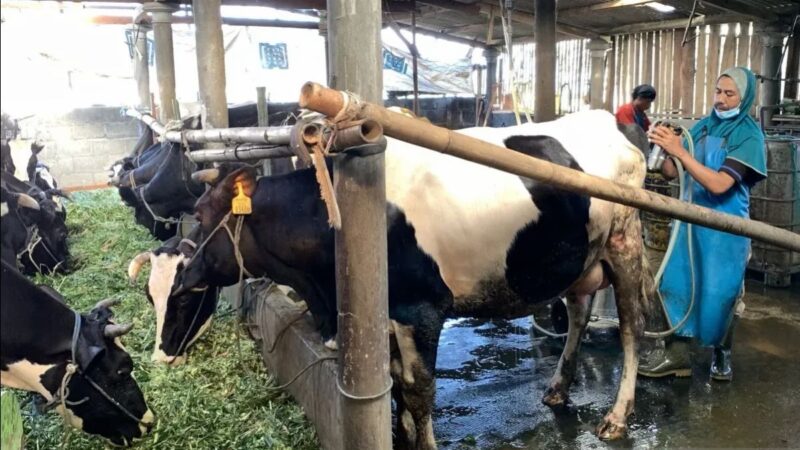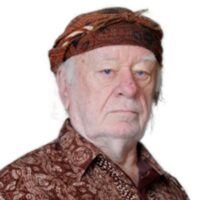While Australian and Kiwi cattle farmers are hoping for a windfall, the Indonesian president’s pet project of serving milk to 83 million youngsters meets an easily foreseen obstacle. Duncan Graham reports.
A headline $45B public health and social welfare presidential initiative has been promised to boost the well-being of millions of school kids. It was also expected to lift Australian dairy farmers’ incomes; that hope looks doomed in the scheme’s present form because of an awkward medical fact.
Most Indonesians and other Asians don’t drink milk because they can’t – they’re lactose intolerant. It’s a genetic fault affecting two-thirds of the Republic’s 280 million population. The theory is that homo sapiens slowly adapted to lactose while domesticating oxen 10,000 years ago in North Europe’s cold climes. Dwellers of the tropics didn’t bother.
A seemingly little-known investigation by the University of Indonesia’s Department of Paediatrics is specific: “The prevalences of lactose malabsorption in pre-elementary, elementary and junior high school children were 21.3 per cent, 57.8 per cent and 73 per cent respectively.”
Drinkers rapidly sicken with abdominal pain, nausea and diarrhoea. Not a good invite to keep consuming.
Other academic studies also show lactose intolerance increases with age, hence some early schoolers may be able to drink and benefit.
Free lunch?
The lunch plan to be launched next year aims to reduce stunting – a condition tragically common in parts of Indonesia, severely damaging development and often leading to early deaths among babes and toddlers.
The suggested solution was unexpectedly announced by cashiered former army general Prabowo Subianto earlier this year when he successfully campaigned to be Indonesia’s eighth president.
He wooed electors with a wholesome menu seemingly scribbled on a serviette during a TV debate ad-break, details to come later. Free food and milk for school kids – and who better to supply the dairy products than Australia and NZ, which have tariff-free export rights?
But planners and the media overlooked lactose intolerance, an awkward medical fact that will dash Australian farmers’ rides on the milk train despite already shipping 50 in-calf heifers this month. Not a big deal – a million cows are needed.
A Rp 71 trillion ($7B) trial of the scheme is planned for next month, targeting 15 million students. Malnutrition is a devilish problem impacting future generations. UNICEF claims the nation next door is struggling with micronutrient deficiencies. Only 40 per cent get “the minimum acceptable diet required for optimal growth and development.”
Existing campaigns to persuade mothers to continue breastfeeding and subsidies for the poor have helped, but an estimated one in 12 Indonesian children aged under five are wasted, and one in five are stunted.
Major health issue
The misery and national shame have drawn widespread outrage with demands for action. So Prabowo’s promise was applauded and probably a major reason he won the three-way contest in February with more than 58 per cent of the vote.
Earlier generations benefitted from the free milk deal introduced by the Menzies Government in 1951 and run for two decades. Older readers will remember ‘milk monitors’ lugging crates into classrooms and having to drink warm bottles as fridges were rare.
It was assumed the idea could migrate to Indonesia. The lactose intolerance reality has been known in nutritionists’ labs for decades, though embarrassingly not in newsrooms and policy nerds’ desks.
That’s why the milk part of the Prabowo strategy is quietly slipping off the menu, though lactose intolerance isn’t mentioned – only cost.
Minister of State Secretary Prasetyo Hadi has dampened expectations, telling the government’s news agency Antara: “Milk is one of the most expensive components in the nutritious meal programme … we need to think of other alternatives besides packaged milk.”
He suggested “liquid milk”, presumably meaning unsterilised, which is more dangerous.
“Some other countries have been doing this for decades. Hence, we seek prayers and support. Please understand that this may not be perfect in the first year.”
Lactose risk
Lactose, also called milk sugar, can be removed, but doing so adds to the cost. Soybean milk is lactose-free and common in Indonesia; it could be a healthy substitute if the cost is acceptable. But that won’t help Oz farmers.
The government claims 83 million youngsters should eventually benefit, though spending has already been slashed from Rp 15,000 ($1.50) a meal down to Rp 10,000.
Many dairy cows are held in smallholders’ barns and milked by hand, their owners cycling to wasteland to slash grass and carry to their beasts.
Big overseas-funded holdings using mechanised systems and specialised foods are developing, often helped by NZ investments and technology. But the bovines are rarely free range; they’re born in byres and die in the same jail cells. Animal welfare groups would be horrified.
The industry has improved through promotions by the late President Soeharto, who was a keen farmer. His artificial insemination scheme using foreign sperm has lifted stock quality, though rarely production.
The yields of Friesians and other European breeds used to mild weather drop in the tropics. Statistics Indonesia reports domestic milk production is less than a million tonnes a year from 585,000 cows.
Food security
Prabowo has made food self-sufficiency a national priority. But that ambition is moving out of reach as farmers to easier city jobs and productive land disappear forever under new suburbs’ concrete and bitumen.
Current Australian exports generally head to factories using skimmed milk powder for processed snacks.
By 2029, the annual cost of the President’s freebies could top Rp 450 trillion ($45 billion). That doesn’t account for budget blowouts and supply hassles in an archipelago of more than 6,000 inhabited islands where the need for nourishing foods is greatest.
Because so many fingers will be in the tucker box, corruption is almost certain. During the Covid crisis, the Komisi Pemberantasan Korupsi (KPK – Corruption Eradication Commission) reported a loss of Rp 125B ($11.9m) through the scamming of a social help programme initiated by Prabowo’s predecessor, Joko ‘Jokowi’ Widodo.
Since then the mainstream media has widely reported that graft controls have weakened.
Supermarket shelves Down Under show shoppers’ priorities: Walls of fridges full of fresh milk with two-litre plastic bottles retailing for around $3 are commonplace in the cities, with the UHT long-life milk selling for $1.60 a litre.
This product in Indonesia costs more than $2 – so only sought by the upper classes. Street vendors sell unsterilised warm milk straight from udders to churns at around a dollar a litre, though often diluted with tap water. Hygiene practices are rarely controlled.
Telling the literal bellyachers to drink up because milk is good for them won’t work in this age, so the leftovers from lactose-intolerant kids’ lunch pails will result in huge wastage.
Not the sort of image Australian dairy farmers imagined.
US President beware. Indonesia embraces Russia, BRICS to build trade … and military
Duncan Graham has a Walkley Award, two Human Rights Commission awards and other prizes for his radio, TV and print journalism in Australia. He now lives in Indonesia.

